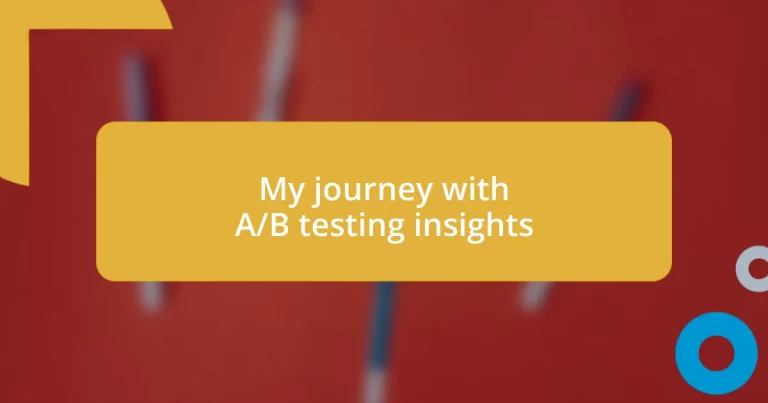Key takeaways:
- A/B testing replaces guesswork with data-driven decisions, enabling continuous experimentation and better user experiences.
- Setting clear objectives is crucial for effective A/B testing, ensuring alignment with business goals and measurable outcomes.
- Continuous improvement through iterative testing reveals insights that enhance user engagement and foster meaningful connections with audiences.
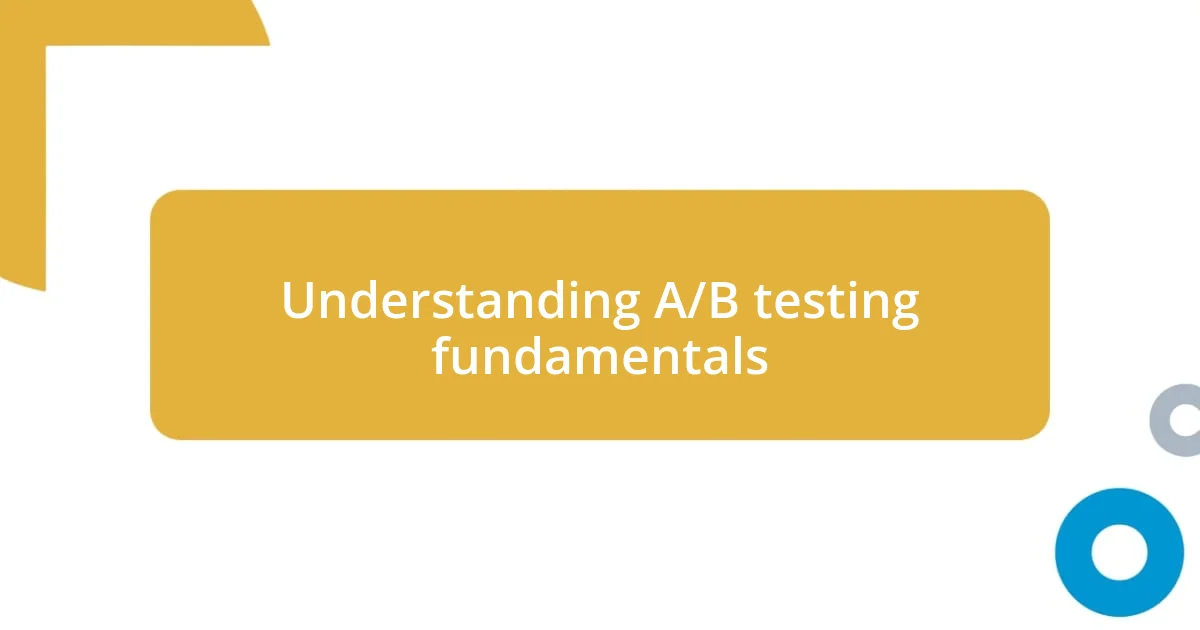
Understanding A/B testing fundamentals
A/B testing, often referred to as split testing, is a method where two versions of a webpage or app are compared to see which performs better. I remember the first time I implemented this technique; I was filled with excitement and a bit of apprehension. Would my hunch about a different button color actually make a difference? That’s the beauty of A/B testing—it transforms guesswork into data-driven decisions.
At its core, A/B testing involves presenting two variations to a segment of users and measuring their responses, typically through metrics like conversion rates or click-through rates. I often reflect on how this process feels like a friendly competition. It’s not just about numbers; it resonates deeply when I see users responding positively to changes I’ve carefully considered. It really drives home the point that every detail matters.
What I find fascinating is how A/B testing encourages a culture of experimentation. Have you ever tried something new out of sheer curiosity? That’s the mindset I adopt every time I run a test. It’s about embracing change and learning from results, which ultimately leads to better user experiences and outcomes. It’s not merely about picking a winner; it’s a continuous journey of understanding what truly resonates with your audience.
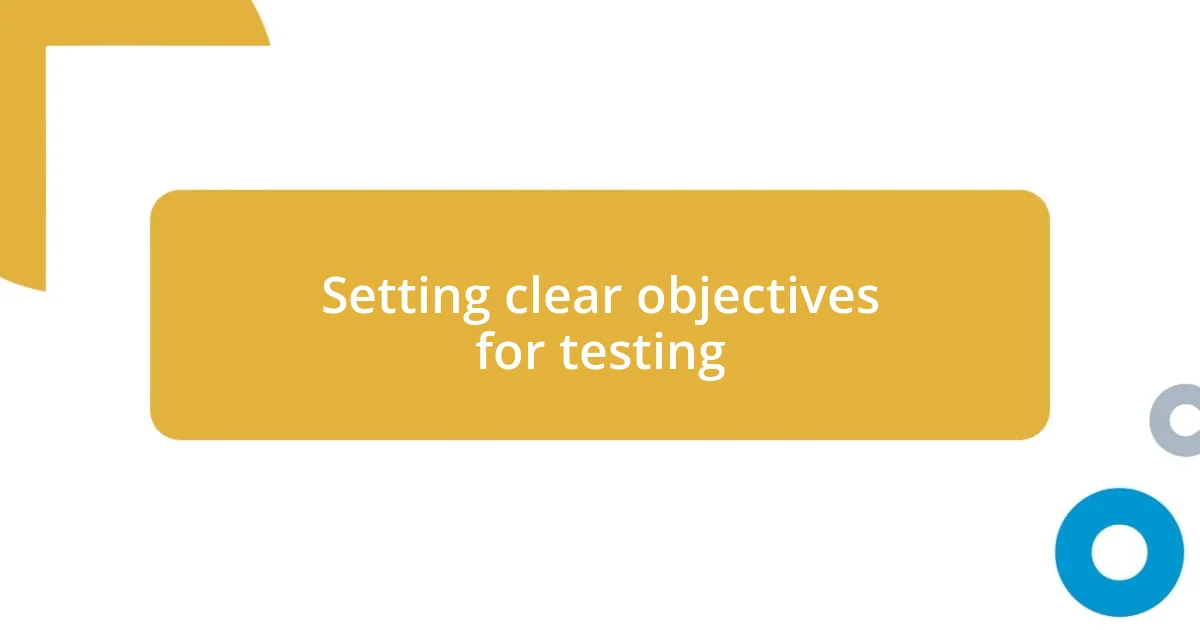
Setting clear objectives for testing
When I first ventured into A/B testing, one crucial insight dawned on me: setting clear objectives is foundational to meaningful results. Without defined goals, it’s easy to get lost in data and miss the bigger picture. I remember a particular instance where my objective was to increase newsletter sign-ups. By zeroing in on that goal, I could tailor my test, measure success accurately, and truly understand the impact of my changes.
Here are some considerations to help you set clear objectives for your A/B testing:
- Define what success looks like: Identify specific metrics you want to improve, like conversion rates or user engagement.
- Prioritize objectives: Focus on the most significant goals first, as this will guide your testing schedule.
- Make objectives measurable: Use numbers and percentages to quantify success, ensuring you can track progress effectively.
- Align with overall strategy: Ensure your testing objectives align with your broader business goals for maximum impact.
- Document lessons learned: Keep a record of insights gained during tests to refine future objectives and strategies.
Setting objectives not only streamlines the testing process but also turns what can feel like a chaotic experiment into an intentional and powerful tool for growth. In my experience, each test became less about the numbers and more about stories—stories of real users whose experience I sought to enhance.
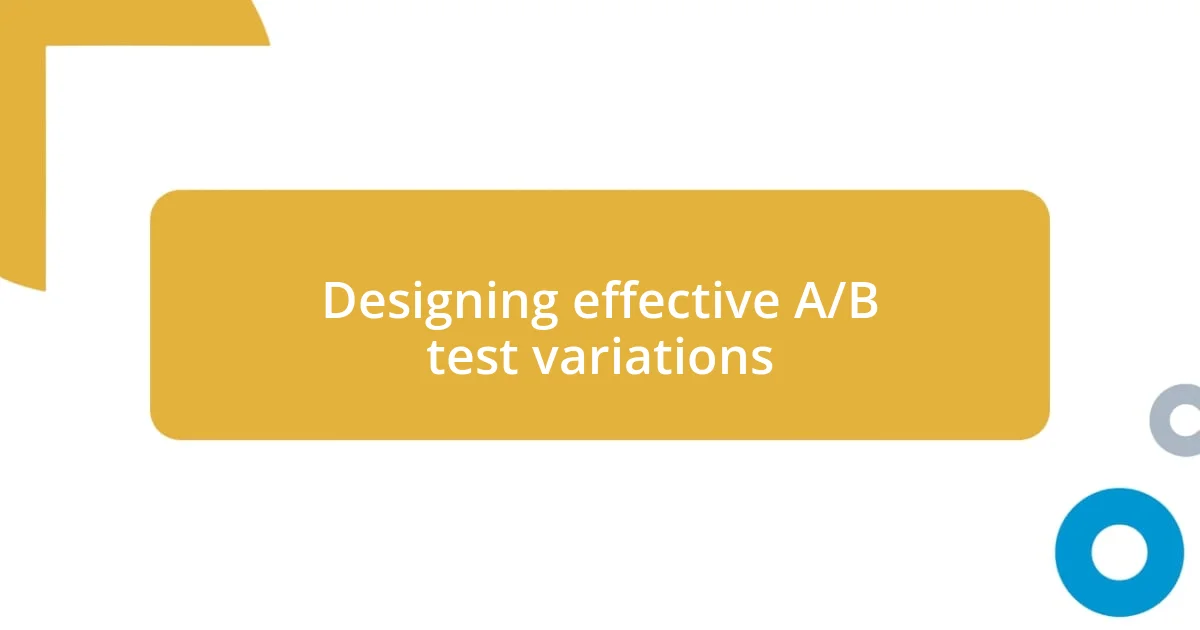
Designing effective A/B test variations
Designing effective A/B test variations requires a careful balance of creativity and analytical thinking. I’ve learned that the variations must be distinct enough to yield clear insights but not so different that the results become ambiguous. For instance, when I experimented with call-to-action buttons, I opted for contrasting colors and different verb choices. The moment I noticed a significant uptick in conversions, I felt a rush of excitement—an affirmation that attention to detail pays off.
Each variation should serve a purpose based on what you aim to discover. A memorable instance for me was when I tested two landing page headlines. One was straightforward, while the other had a playful twist. The playful option not only captured attention but also increased the time users spent on the page. It underscored the importance of understanding user psychology—not just what looks good but what resonates. I can’t stress enough how vital it is to research and understand your target audience; it empowers you to design variations that hit the mark.
I’ve found that testing small details can lead to surprisingly big results. For example, I once altered the placement of a search bar slightly, and that simple change led to a noticeable improvement in user satisfaction based on feedback. Variations don’t need to revolve around dramatic shifts; sometimes, it’s the subtleties that yield the highest impact.
| Variations | Purpose |
|---|---|
| Color Change | Assess user reaction to design elements |
| Word Choice | Test emotional impact on engagement |
| Layout Shift | Gauge usability and accessibility |
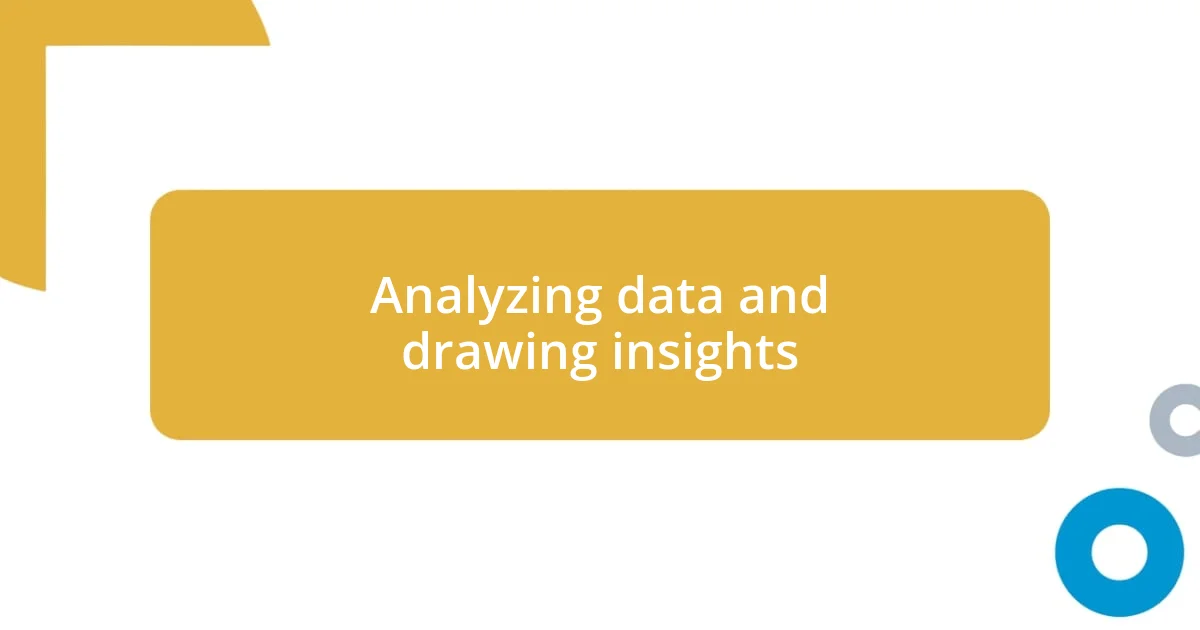
Analyzing data and drawing insights
Analyzing data and drawing insights from A/B testing results can be a revelation, and I found it is easier when I let the data speak. After running my first tests, I remember staring at spreadsheets filled with numbers and wondering where to begin. It wasn’t until I started visualizing the data through graphs that patterns began to emerge. Have you ever noticed how much clearer insights can become with a simple chart? For me, visual representation transformed raw data into actionable stories, allowing me to identify which variations truly resonated with users.
One memorable analysis involved an e-commerce campaign where I tested two promotional banners. The data showed not only a spike in clicks for the more engaging design but also how long users spent on the page afterwards. It was fascinating to see the direct correlation between their emotional response to the banner and their subsequent behavior. I can’t emphasize enough how key it is to look beyond the immediate conversion rate—sometimes, understanding user engagement depths opens even more doors to explore.
Reflecting on these insights led me to develop a habit: I consistently questioned how each piece of data tied back to my initial objectives and what story it was telling about user behavior. This approach not only refined my understanding but also kept my testing aligned with genuine user needs. Have you tried this yourself? Keeping a focused narrative in mind while analyzing allows for deeper engagement with the data and ultimately, better decisions for future testing.
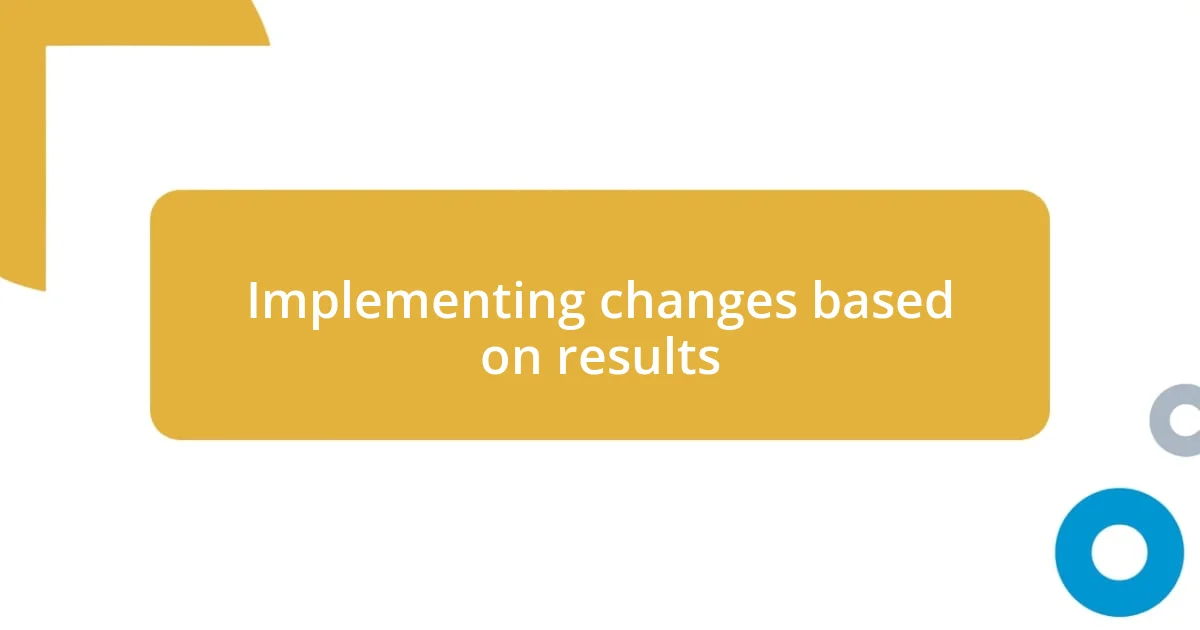
Implementing changes based on results
When it comes to implementing changes based on A/B testing results, I’ve learned that the process is as critical as the testing itself. After identifying a winning variation, I vividly recall the feeling of anticipation as I prepared to roll it out. I often ask myself, “How will this change resonate with our users?” This mindset helps me align my decisions with user expectations, ensuring that modifications not only reflect data but also enhance the overall user experience.
Once, after discovering that a particular email subject line significantly boosted open rates, I couldn’t wait to apply this newfound knowledge. I remember modifying my future email campaigns to align with that style, and it felt like a breath of fresh air—seeing the engagement levels rise was a satisfying confirmation that the change was valid. It made me realize that implementing results isn’t just about numbers; it’s about connecting with your audience in a genuine way.
As I’ve continued down this path, I’ve become more intuitive about the impact of my changes. I often reflect on previous tests and think, “What can this teach me moving forward?” In one instance, a small tweak to our website’s navigation led to not just increased traffic, but also a noticeable drop in bounce rates. This taught me the importance of ongoing assessments. Each iteration fuels my curiosity and sharpens my ability to craft experiences that truly resonate.
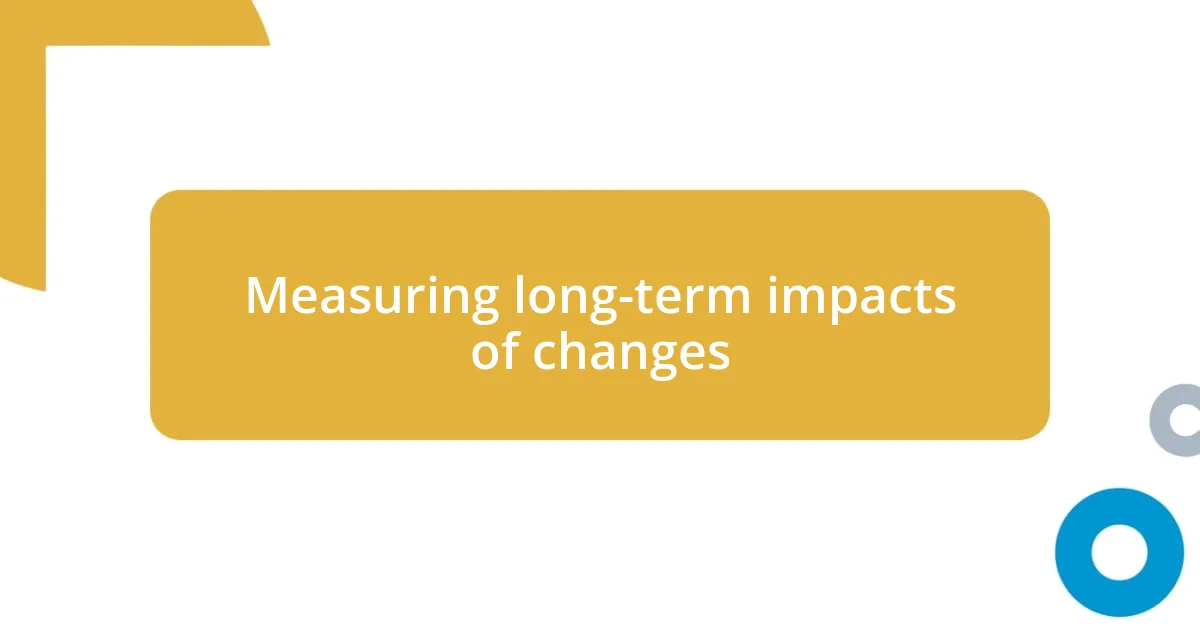
Measuring long-term impacts of changes
Measuring long-term impacts of changes involves tracking metrics beyond immediate results. After implementing a new feature, I often find myself contemplating, “How is this change affecting user behavior over time?” For instance, I tracked the adjustments made after a redesign to our mobile app. Initially, everything seemed promising with increased downloads, but it was the sustained user retention that truly showcased the redesign’s success.
In one project, I also set up a system to measure customer satisfaction alongside conversion rates. It was eye-opening to see that while conversions surged, the NPS (Net Promoter Score) dipped slightly. This revealed that some users weren’t thrilled with the changes. It made me realize that not all improvements are linear; sometimes, fostering a better long-term relationship with users requires a more nuanced approach. Have you had a similar experience where initial success masked underlying issues?
As I continue to analyze the effects of changes, I’ve learned the importance of a feedback loop. After noticing a pattern in user drop-off rates post-implementation, I began to gather qualitative feedback to understand the “why” behind it. This insight prompted me to engage users directly, sparking conversations that unearthed their concerns. I discovered that their experience didn’t align with our expectations, and it highlighted the necessity of continuous monitoring and adjustment. It’s a journey of discovery that keeps evolving, making it both challenging and exhilarating.
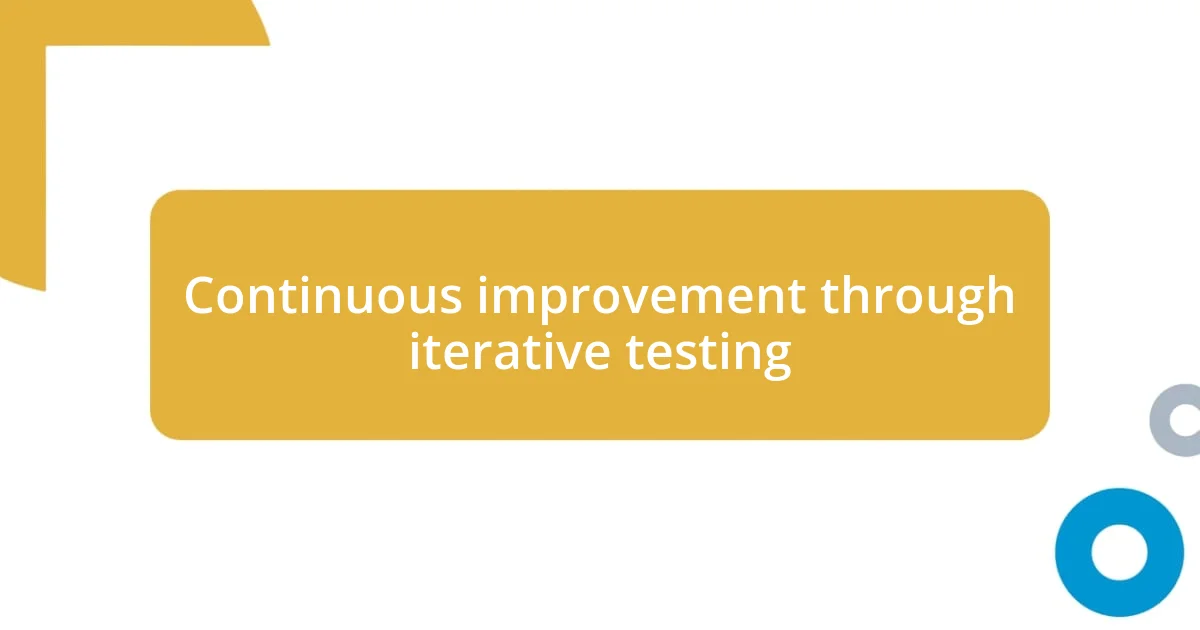
Continuous improvement through iterative testing
Continuous improvement thrives in an environment of iterative testing. Every time I run an A/B test, it feels like peeling layers off an onion. With each layer I remove, new insights come to light, revealing opportunities I hadn’t considered before. I vividly remember testing different landing page layouts; the thrill of seeing one version outperform the other brought a sense of urgency. I often wonder, “What else can I refine to enhance the user journey?” That curiosity fuels my drive to continuously tweak and optimize.
One experience really stands out in my mind. I had implemented a color change in a call-to-action button and eagerly anticipated user interactions. The initial results showed a modest increase in clicks, but surprisingly, what followed was a steady upward trend in customer sign-ups over the next few weeks. It made me realize the ripple effect of even subtle adjustments. Suddenly, I was asking myself, “How much more could I explore through this lens of incremental changes?” The satisfaction of witnessing those prolonged impacts motivated me to dig deeper with each subsequent test.
As I reflect on my journey, I see that continuous improvement is almost like a dance with data. It’s rewarding to witness this evolving relationship. Each test feels less like a solitary act and more like a collaborative effort with my audience. Engaging in this cycle of testing, analyzing, and implementing not only strengthens my strategies but also fosters meaningful connections with users. This iterative process creates a foundation for growth that is not just about numbers; it’s about resonance. How do you approach your own iterations—do you feel the same exhilarating anticipation when insights emerge?












